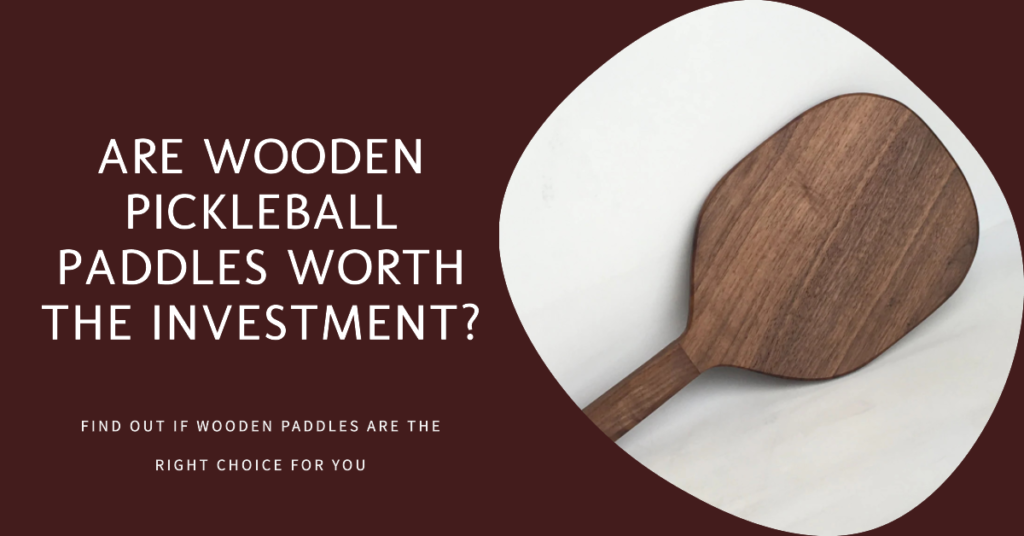Wooden pickleball paddles can be a good option for players due to their affordability and durability. Choosing the right pickleball paddle is crucial for players looking to enhance their gameplay and performance.
Wooden pickleball paddles, in particular, offer a range of benefits that make them a viable choice for many players. One notable advantage is their affordability, as wooden paddles are generally more cost-effective than other materials. Additionally, wooden pickleball paddles are known for their durability, making them a long-lasting option for players who want to avoid frequent paddle replacements.
While wooden paddles may not perform as well as their composite or graphite counterparts, they can still be a good choice for casual players or those on a budget. So, if you’re looking for a budget-friendly, durable option, wooden pickleball paddles can be a good choice.
Why Choose Wooden Pickleball Paddles
Wooden pickleball paddles offer a unique blend of durability and performance, making them an excellent choice for players looking for a reliable option. With their natural feel and excellent control, wooden paddles can enhance your game while standing up to the rigors of intense play.
Durability And Longevity
When choosing the right pickleball paddle, durability and longevity are key factors. Wooden pickleball paddles are known for their exceptional durability, making them a reliable choice for players of all levels. Here’s why you should choose wooden pickleball paddles:
- Durability: Wooden paddles are designed to withstand the rigors of the game, offering excellent resistance against impact and wear. Their solid construction ensures they can withstand powerful shots and intense gameplay, making them a long-lasting investment.
- Longevity: Wooden paddles have a reputation for their extended lifespan. With proper care and maintenance, these paddles can serve you well for years, offering consistent performance and reliability. Their sturdy build means you won’t have to worry about replacing your paddle frequently.
- Authentic Feel and Sound: One of the distinct advantages of wooden paddles is the original feel and sound they provide. When striking the ball, wooden paddles produce a satisfying, resonating sound that many players appreciate. This traditional feel and sound add to the overall playing experience and enhance the game’s enjoyment.
- Suitable for Beginners: Wooden paddles are often recommended due to their forgiving nature. They offer reasonable control and a more prominent sweet spot, making it easier for beginners to make accurate shots. The wood’s natural characteristics provide a softer touch, allowing players to focus on developing their skills without being overwhelmed by the paddle’s performance.
- Environmentally Friendly Option: Wooden paddles are more environmentally friendly than other materials such as graphite or composite. Wood is a renewable resource, and choosing a wooden paddle helps minimize environmental impact. By embracing wooden paddles, you can enjoy the game while contributing to sustainable practices.
Wooden pickleball paddles are an excellent choice for players seeking durability, authenticity, and beginner-friendly features. Their long-lasting nature, authentic feel and sound, suitability for beginners, and eco-friendly attributes make them versatile for players at all skill levels. Embrace the durability and charm of wooden paddles and elevate your pickleball game to new heights.
The Performance Of Wooden Pickleball Paddles
Wooden pickleball paddles offer excellent performance, combining durability and control. They are a popular choice for players looking for a reliable and long-lasting option on the court.
Are Wooden Pickleball Paddles Good? Wooden pickleball paddles have been a topic of debate among pickleball enthusiasts. We will explore the performance of wooden pickleball paddles and how they compare to other paddle materials.
Control And Precision:
- Wooden paddles offer excellent control and precision due to their solid construction and slightly heavier weight compared to other paddles.
- The natural feel of wood gives players a better grip on the paddle, resulting in enhanced control over the ball.
- The paddle’s weight distribution enables players to make precise shots and have more control over ball placement.
Power And Shot Placement:
- While wooden paddles may not provide the same power as composite or graphite paddles, they can still generate a decent amount of energy.
- The additional weight of the wooden paddle contributes to more vital shots and allows players to hit the ball with more force.
- Wooden paddles also offer an advantage in shot placement, as the paddle’s weight distribution helps players direct the ball with accuracy and finesse.
Spin And Ball Control:
- Wooden paddles excel in spin generation and ball control.
- The textured surface of these paddles grips the ball effectively, allowing players to add spin to their shots.
- Players can quickly put topspin or backspin on the ball, making it more challenging for opponents to return.
- This advantage in spin control enhances the player’s ability to manipulate the ball trajectory and strategically place shots.
Handling Different Playing Surfaces:
- Wooden paddles are versatile and perform well on various playing surfaces, including indoor and outdoor courts.
- The solid construction of wooden paddles allows them to withstand the rigors of different playing conditions.
- The paddle’s weight and balance provide stability and control on different surfaces, ensuring consistent performance.
Wooden pickleball paddles offer several advantages in control, precision, shot placement, spin generation, and ball control. While they may not match the power of composite or graphite paddles, wooden paddles can still be an excellent choice for players looking for heightened supervision and finesse in their game.
Maintenance And Care Tips For Wooden Pickleball Paddles
Wooden pickleball paddles require regular maintenance and care to ensure their longevity. By regularly cleaning the paddle surface, storing it in a dry place, and avoiding excessive exposure to sunlight, you can keep your wooden paddle in good condition for more extended.
Cleaning And Drying:
- Regular cleaning and proper drying are essential to maintain the quality and longevity of your wooden pickleball paddle.
- Clean the paddle after each use to remove dirt, sweat, and other residues that can accumulate on the surface.
- Use a damp cloth or sponge to wipe down the paddle, ensuring no excess moisture is left behind.
- Avoid using harsh chemicals or abrasive materials that could damage the wood.
- Allow the paddle to air dry thoroughly before storing it to prevent mold or mildew growth.
- Place the paddle in a well-ventilated area and avoid direct sunlight or heat sources that could cause warping.
Protecting The Surface:
- Protecting the surface of your wooden pickleball paddle is vital to maintaining its integrity and performance.
- Regularly apply a thin layer of protective oil or sealant to the paddle’s surface.
- This helps to seal the wood, preventing it from absorbing moisture and reducing the chances of warping or cracking.
- Follow the manufacturer’s guidelines for the appropriate type and frequency of oil or sealant application.
- Use a paddle cover or case when not in use to shield the paddle from dust, moisture, and accidental damage.
- Ensure the cover is breathable, allowing for proper air circulation and preventing moisture buildup.
Checking For Damage:
- Regularly inspect your wooden pickleball paddle for any signs of damage or wear.
- Look for cracks, splinters, or rough spots on the surface, handle, and edges.
- Press the paddle gently to check for soft or weak spots that may indicate internal damage.
- If you notice any significant damage, it’s best to consult a professional or replace the paddle to avoid compromising your play and safety.
Resurfacing And Refinishing:
- Over time, the surface of a wooden pickleball paddle may wear out, affecting its performance.
- If the paddle’s surface becomes rough or shows signs of wear, resurfacing or refinishing can help restore its playing characteristics.
- Sanding the surface with fine-grit sandpaper can smoothen out minor imperfections and restore the paddle’s original texture.
- Sanding evenly and following the wood grain is crucial to prevent damage.
- After sanding, apply a protective sealant or oil to the surface to rejuvenate the wood and provide adequate protection.
Taking proper care of your wooden pickleball paddle ensures it remains in optimal condition, allowing you to enjoy the sport to the fullest. Regular cleaning, protective measures, periodic inspections, and potential resurfacing can help you maintain the performance and longevity of your paddle.
With these maintenance tips, you can keep your wooden pickleball paddle in excellent shape for many future games.
Comparing Wooden Pickleball Paddles To Other Materials
Wooden pickleball paddles offer a unique feel and control compared to other materials. Their natural construction provides a traditional touch to the game, making them a good choice for players seeking a classic experience on the court.
Are Wooden Pickleball Paddles Good?
Wooden pickleball paddles offer a classic feel and durability that many players appreciate. However, as technology has advanced, alternative materials such as fiberglass, graphite, composite, aluminum, and carbon fiber have become popular choices for pickleball paddles. In this section, we will compare wooden pickleball paddles to these other materials to help you decide which paddle is best for you.
Fiberglass And Graphite Paddles:
- Lightweight: Fiberglass and graphite paddles are often much lighter than wooden paddles, allowing for quicker reaction times and increased maneuverability on the court.
- Power and Control: These materials provide more power and control due to their enhanced responsiveness, making it easier for players to generate speed and put spin on the ball.
- Durability: Fiberglass and graphite paddles are highly durable and can withstand the rigors of intense pickleball gameplay, ensuring longevity and consistent performance over time.
- Vibrations: Unlike wooden paddles, fiberglass and graphite paddles tend to dampen vibrations, reducing strain on the player’s arm and enhancing comfort during play.
Composite Paddles:
- Blend of Materials: Composite paddles combine different materials, such as fiberglass with polymer cores, to create a balanced paddle that offers power, control, and durability.
- Versatility: Composite paddles are designed to provide all-around performance, making them suitable for players of all skill levels and playing styles.
- Weight Options: Composite paddles come in various weight options, allowing players to choose a paddle that suits their preferences and playing style.
- Enhanced Sweet Spot: The composite construction of these paddles enlarges the sweet spot, increasing forgiveness on off-center hits and improving overall shot consistency.
Aluminum Paddles:
- Sturdiness: Aluminum paddles are known for their durability and ability to withstand heavy impacts, making them a reliable option for aggressive players who often hit the ball forcefully.
- Weight: These paddles generally tend to be heavier than their wooden counterparts, providing stability and reducing vibration.
- Shock Absorption: Aluminum paddles excel in shock absorption, reducing strain on the player’s arm and minimizing fatigue during long games.
- Lower Cost: Compared to other materials, aluminum paddles are often more affordable, making them an excellent option for players on a budget.
Carbon Fiber Paddles:
- High Performance: Carbon fiber paddles deliver exceptional power, control, and precision due to their outstanding stiffness, making them a top choice for competitive players.
- Lightweight: These incredibly light paddles allow players to maneuver quickly and effortlessly around the court while maintaining excellent shot accuracy.
- Minimal Vibration: Carbon fiber’s stiffness minimizes vibrations, ensuring players enjoy a comfortable and smooth playing experience while reducing the risk of arm strain.
- Expensive: Carbon fiber paddles tend to be at the higher end of the price spectrum, making them a premium choice for serious players who prioritize performance.
While wooden pickleball paddles bring a classic aesthetic and solid durability to the game, alternative materials like fiberglass, graphite, composite, aluminum, and carbon fiber offer unique advantages such as enhanced power, control, lightweight construction, and improved shock absorption. Consider your playing style, preferences, and budget when selecting the suitable material for your pickleball paddle, as it can significantly impact your performance on the court.
Choosing The Right Wooden Pickleball Paddle
Wooden pickleball paddles can be a good choice for players who prefer a traditional feel. These paddles offer a unique combination of control and power, making them suitable for players of all skill levels. With careful consideration of weight and grip, you can find the perfect wooden paddle for your pickleball game.
Are Wooden Pickleball Paddles Good?
Wooden pickleball paddles are popular among players due to their durability and affordability. However, choosing the right wooden pickleball paddle requires careful consideration of several factors. This section will explore wood types and construction, weight and grip size, shape surface area, balance, and maneuverability.
Let’s dive in!
Wood Types And Construction
Wooden pickleball paddles are typically made from composite wood or solid wood. Here are some key points to consider:
- Composite Wood: These paddles are constructed by layering different types of wood together, resulting in improved durability and performance.
- Solid Wood: Solid wood paddles are made from a single piece of wood and are known for their traditional feel and sound.
Weight And Grip Size
A wooden pickleball paddle’s weight and grip size can significantly impact your gameplay. Here are a few things to keep in mind:
- Weight: Lighter paddles offer increased maneuverability, while heavier ones provide more power and stability.
- Grip Size: The right grip size is crucial for comfort and control. Measure the length between your palm and the tip of your ring finger to determine the ideal grip size.
Shape And Surface Area
A wooden pickleball paddle’s shape and surface area will affect your shot accuracy and control. Consider the following:
- Shape: Paddles come in different forms, such as elongated, widebody, and standard. Each profile offers unique benefits, so choose one that suits your playing style.
- Surface Area: A larger surface area provides a more prominent sweet spot, making it easier to hit the ball consistently.
Balance And Maneuverability
The balance and maneuverability of a wooden pickleball paddle can significantly impact your agility on the court. Pay attention to the following:
- Balance: Paddles can be head-heavy, evenly balanced, or handle-heavy. Head-heavy paddles offer more power, while handle-heavy ones provide better control. Evenly balanced paddles offer a combination of both.
- Maneuverability: A paddle’s weight distribution and shape play a role in overall maneuverability, allowing you to react swiftly during fast-paced rallies.
Selecting the right wooden pickleball paddle involves considering factors such as wood type and construction, weight and grip size, shape surface area, balance, and maneuverability. By understanding these aspects, you can find a paddle that suits your playing style and enhances your overall performance on the court.
Happy pickleball playing!
Aesthetic Appeal Of Wooden Pickleball Paddles
Wooden pickleball paddles offer an aesthetically appealing option for players. Crafted with natural materials, they provide a timeless and classic look while maintaining durability and performance on the court. Discover the unique charm and functionality of wooden pickleball paddles today.
Natural Beauty And Grain Patterns
- Wooden pickleball paddles offer a unique natural beauty that differentiates them from their composite or graphite counterparts.
- Wood’s rich colors and grain patterns create a visually appealing paddle that stands out on the pickleball court.
- Each paddle has its distinct look, with variations in wood types and grain patterns, making every paddle a one-of-a-kind piece.
Customization Options
- Wooden paddles provide an excellent opportunity for customization, allowing players to make their paddles their own.
- Players can choose from different types of wood, such as ash, maple, or plywood, each offering its own characteristics and performance benefits.
- It is also possible to personalize the paddle by adding custom graphics, laser engravings, or a personalized handle shape, creating a paddle that reflects the player’s style and preferences.
Retro And Vintage Style
- Wooden pickleball paddles evoke a sense of nostalgia and bring a touch of retro and vintage style to the game.
- With their classic wooden appearance, these paddles offer a throwback to the early days of pickleball when wooden paddles were the norm.
- This vintage aesthetic looks excellent and adds a unique charm and character to the gameplay experience.
Creating A Personal Connection
- Wooden paddles have a way of creating a personal connection between the player and their paddle.
- The natural feel and warmth of the wood in hand can enhance the overall playing experience, generating a sense of comfort and familiarity.
- Wooden paddles often develop a patina over time, showing signs of wear and becoming an extension of the player’s journey and memories on the court.
Wooden pickleball paddles excel in their aesthetic appeal and provide players with customization options, a touch of retro style, and the ability to create a personal connection with their equipment. Embracing the natural beauty and grain patterns, these paddles offer a visually stunning and distinct choice for those seeking a unique playing experience.
So, why not try a wooden paddle and add natural charm to your pickleball game?
Frequently Asked Questions On Are Wooden Pickleball Paddles Good
Can You Use A Wooden Paddle For Pickleball?
Yes, you can use a wooden paddle for pickleball.
Is There A Difference In Pickleball Paddles?
Yes, there is a difference in pickleball paddles. They vary in materials, weight, and design.
How Do You Know When A Pickleball Paddle Is Worn Out?
You can know when a pickleball paddle is worn out by checking for fraying or loose edges.
What Is The Difference Between Carbon Fiber And Fiberglass Pickleball Paddles?
Carbon fiber and fiberglass pickleball paddles differ in the materials used, with carbon fiber being lighter, stiffer, and more expensive.
Conclusion
Wooden pickleball paddles have been a debate among players, with arguments for and against their effectiveness. While they may not provide the same power and speed as their composite or graphite counterparts, wooden paddles do have their advantages.
They offer a comfortable grip and excellent control, making them ideal for beginners or players looking to improve their technique. Additionally, wooden paddles are durable and can withstand more intense play, making them a cost-effective option in the long run.
However, it’s important to note that wooden paddles have limitations that are limited for advanced players seeking a competitive edge. Ultimately, choosing a wochoosingown is due to personal preference, playing style, and skill level.
Whether you choose a wooden, composite, or graphite paddle, finding one that feels comfortable and enhances your game is critical.






